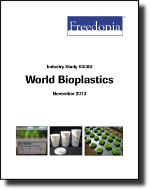Global demand for biobased and biodegradable plastics will rise 19 percent per year to 950,000 metric tons in 2017. The bioplastics industry, while still in the emerging growth phase, has established itself as a fixture in a number of commercial markets and applications. Robust growth in demand is expected in virtually all geographic markets, stimulated by consumer preferences for sustainable materials, the increased adoption of bioplastics by plastic processors and compounders, and new product development that expands the range of uses for bioplastics.
Despite the rapid increase in demand, bioplastics are still expected to account for less than one percent of the overall plastic resin market in 2022. The success of the bioplastics industry will ultimately depend on price and performance considerations, and large scale conversion to bioplastics will not occur until price parity with conventional plastic resins is achieved.
Biobased commodity to post fastest growth
Starch-based resins and polylactic acid (PLA) will remain the leading bioplastic products through 2017, combining to account for over 60 percent of demand. For starch-based resins, advances will be bolstered by increased regulation of conventional plastic products, particularly plastic bags, as governments around the world continue to promote sustainability. PLA demand will benefit from the development of resins and compounds with enhanced performance for more durable applications such as fibers, automotive parts, and electronic parts.
The most rapid gains in demand, however, are expected for biobased commodity resins such as polyethylene and polypropylene, which are just beginning to enter the commercial market. The rapid adoption of these bioplastics will be fueled by their ability to be used as a “drop-in” for existing applications, as well as an increased focus on biobased content rather than biodegradability as a desired attribute. By 2022, biobased polyethylene terephthalate (PET) is also expected to become available in commercial quantities and begin to penetrate the beverage container market.
Brazil to become leading global producer
Western Europe was the largest regional consumer of bioplastics in 2012, accounting for over half of global demand. The region will see strong gains through 2017 as well, bolstered by added regulations and incentives that favor bioplastics over conventional resins. North American demand is expected to more than double, driven by rising consumption of PLA and biobased commodity resins. Advances in the Asia/Pacific region will be fueled by robust growth in China, which has become a major consumer of bioplastic resins used to produce manufactured goods for export.
World bioplastics production used to be concentrated in the US and Western Europe. This began to change in 2012 as production of biobased polyethylene came online in Brazil, and the addition of future capacity will likely make the country the world’s leading producer of bioplastics by 2022. Furthermore, China and Thailand are expected to become some of the top world bioplastics producers.
Study coverage
This study, World Bioplastics, presents historical demand data for 2002, 2007 and 2012, plus forecasts for 2017 and 2022 by product, market, world region, and for 17 countries. The study also considers key market environment factors, evaluates company market share and profiles 34 global industry players.
 Study #: 3089
Study #: 3089
Document Type: Industry Study
Date Published: Nov-2013
Format: Full study: PDF
Section, Pages, Tables and Charts: HTML
Pages: 367
Price: $6,300.00
This Freedonia study is currently for sale only as a full edition in print or PDF format. It will be available for purchase by the page or chapter approximately 60 days from the publication date listed above.
Source
Freedonia Group, press release, 2013-11.
Supplier
Share
Renewable Carbon News – Daily Newsletter
Subscribe to our daily email newsletter – the world's leading newsletter on renewable materials and chemicals










